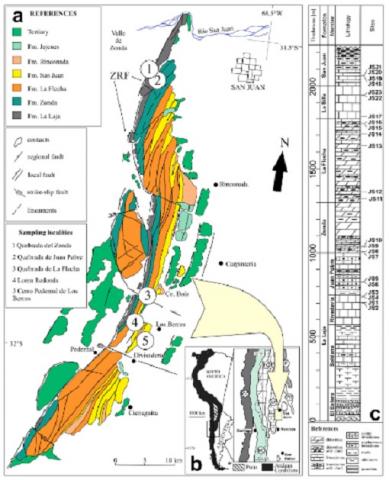Sabrina Y. Fazzito, Augusto E. Rapalini, Daniel G. Poiré
2 017
Journal of South American Earth Sciences Volume 79, November 2017, Pages 67-94
Systematic rock-magnetic and magnetofabric studies were carried out on samples from twenty-three palaeomagnetic sites distributed on the La Laja, Zonda, La Flecha, La Silla and San Juan Formations, which constitute a thick middle Cambrian to early Ordovician carbonate sequence exposed in the Eastern Precordillera of Argentina. Previous palaeomagnetic studies on these rocks showed that this succession is characterized by a recent full overprint in the lower levels and a post-tectonic Permian remagnetization associated to the widespread Sanrafaelic event in the upper part. Our investigation revealed that the fluctuations of the magnetic properties are stratigraphically (lithologically) controlled. Anisotropy of magnetic and anhysteretic susceptibility measurements defined consistent fabrics along the entire section that switch progressively from “inverse”, at the bottom, to “normal”, at the top, with “intermediate” fabrics occurring mainly at medium levels. Degree of dolomitization significantly affects many rock-magnetic parameters, but appears unrelated to the presence of the Permian remagnetization, which is determined to reside in magnetite despite the complex magnetic mineralogy shown by the studied carbonates. Hysteresis cycles of rocks affected by the Sanrafaelic remagnetization are governed by ferromagnetic fractions showing a clear difference respect to those not affected and characterized by the dominance of paramagnetic or diamagnetic signals. The magnetic fabrics and mineralogical characterization rule out a thermoviscous origin and suggest a chemical remagnetization originated in the authigenic formation of magnetite for the Sanrafaelic overprint. X-ray diffraction analyses indicate that clay minerals are virtually absent in the whole succession with no traces of illite in any sample, discarding burial diagenesis of clay minerals for the origin of the remagnetization. Lack of late Palaeozoic magmatic rocks near the study area difficults correlation of this event with hydrothermal brines as well as casts serious doubts on any effect produced by an assumed geothermal anomaly associated with the Permo-Triassic Choiyoi magmatic province. The original model of remagnetization associated to chemically active fluids expelled from the San Rafael Orogen towards the foreland still holds as a viable mechanism.

